This post may contain affiliate links. Please read our disclosure policy.
Sautéed Napa Cabbage is a simple Chinese vegetable stir-fry that’s quick, light, and packed with flavor. My version adds shiitake mushrooms for extra depth, but you can easily make it without—they’re optional, not essential.
This easy side dish is ready in about 20 minutes and comes together with garlic, ginger, and napa cabbage’s natural sweet juiciness. It’s one of my favorite everyday stir-fries and exactly the kind of simple napa cabbage dish people love to come back to.
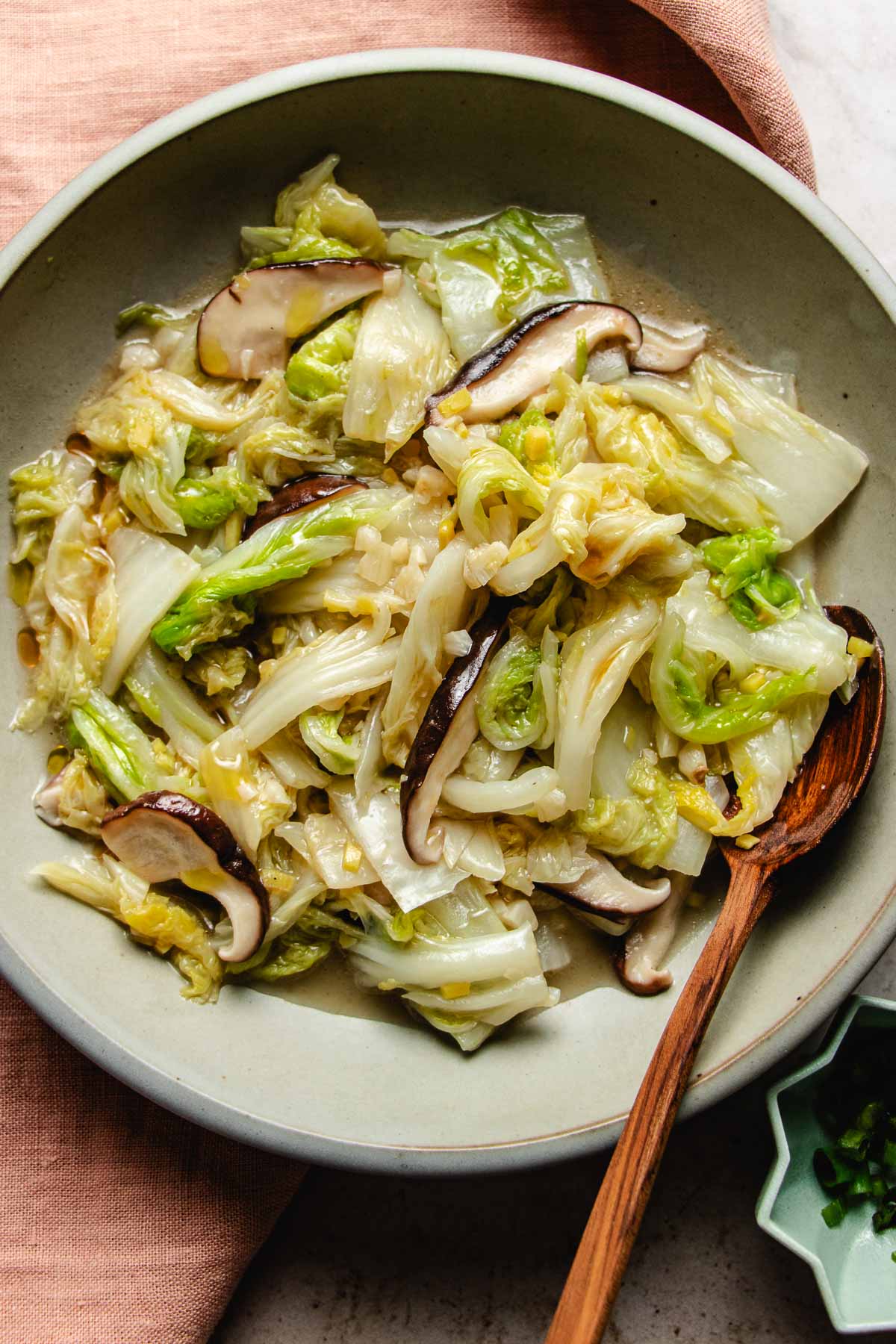
Table of Contents
Main Ingredient Notes
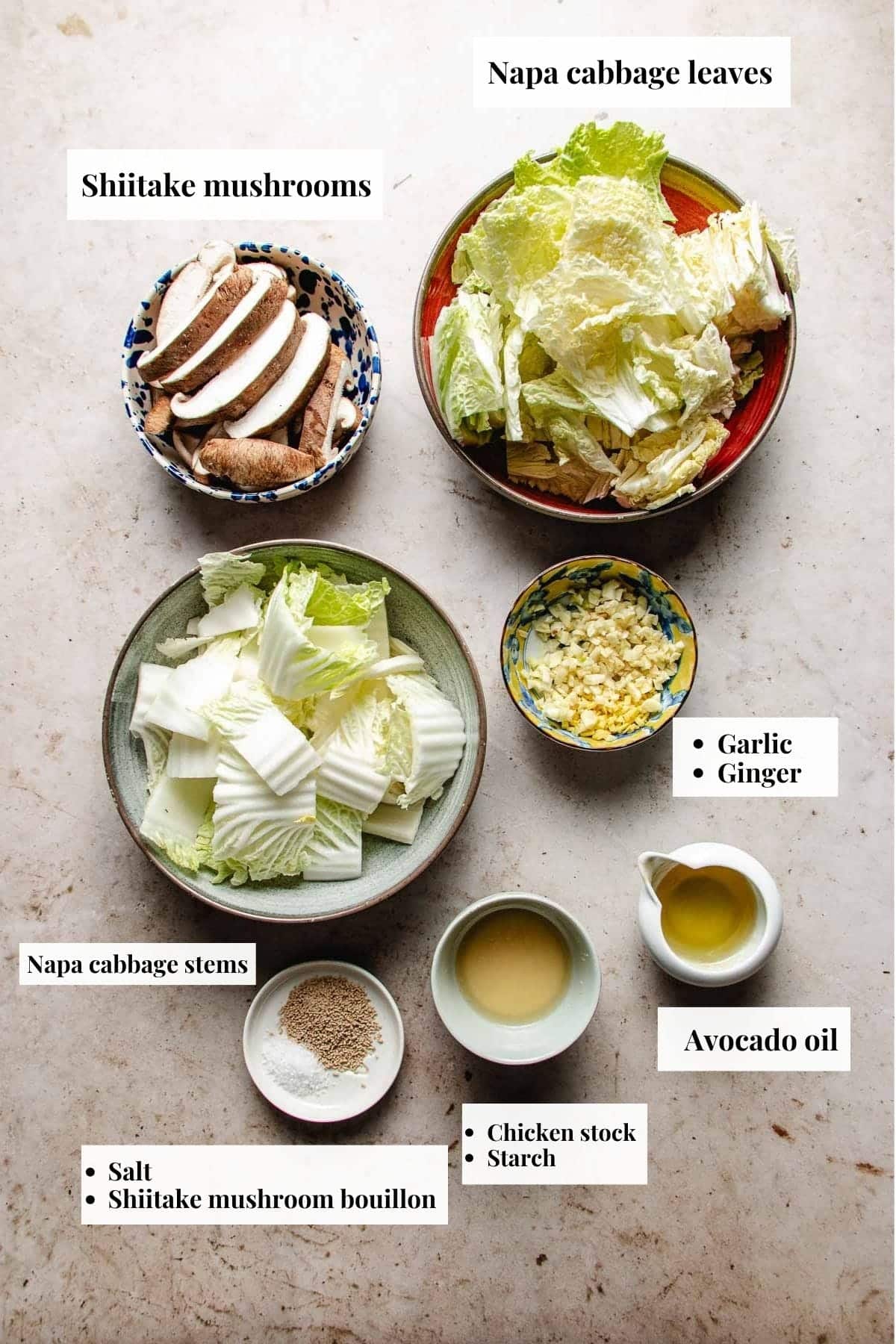
- Napa cabbage (a.k.a. Chinese cabbage): Look for a head that feels heavy in your hand with tightly packed, pale green leaves. Skip the ones that feel light or hollow—they’re usually dry and fibrous. A good one should feel dense and juicy with a crisp, slightly sweet bite.
- Aromatics – garlic, ginger & shiitake: Since this dish is vegetarian, you need a big flavor from the base. Garlic and ginger give the stir-fry depth and warmth, while shiitake mushrooms (fresh or rehydrated dried shiitake) add that woodsy, umami-rich backbone.
- Shiitake mushroom seasoning (or chicken bouillon): This is your flavor booster. Just a little bit adds so much depth and makes the whole dish taste like it came from a restaurant.
- Tapioca starch + chicken stock: This light slurry gives the dish a silky finish and helps the flavor cling to the cabbage. Since napa cabbage releases sweet moisture as it cooks, the starch pulls it all together and keeps the texture balanced.
Tip
Napa cabbage Substitutes
If you can’t find napa cabbage, try baby napa cabbage—also called wawa choy in Asia. It looks just like napa but smaller and is the perfect swap.
You can also use baby bok choy, though it won’t have that naturally sweet, fuller flavor that napa gives.
As a last resort, thinly shredded savoy cabbage will work. Just keep in mind it’s less juicy, so you’ll likely need a longer cook time and a bit more liquid to keep it moist.
How to stir fry napa cabbage
To get that perfect texture—tender stems and wilted leaves without turning soggy—it all comes down to how you slice the cabbage and the order you cook things in. Napa cabbage has a naturally sweet, juicy flavor, but if it’s not prepped right, it can go watery or mushy fast. Follow these steps to get it just right.
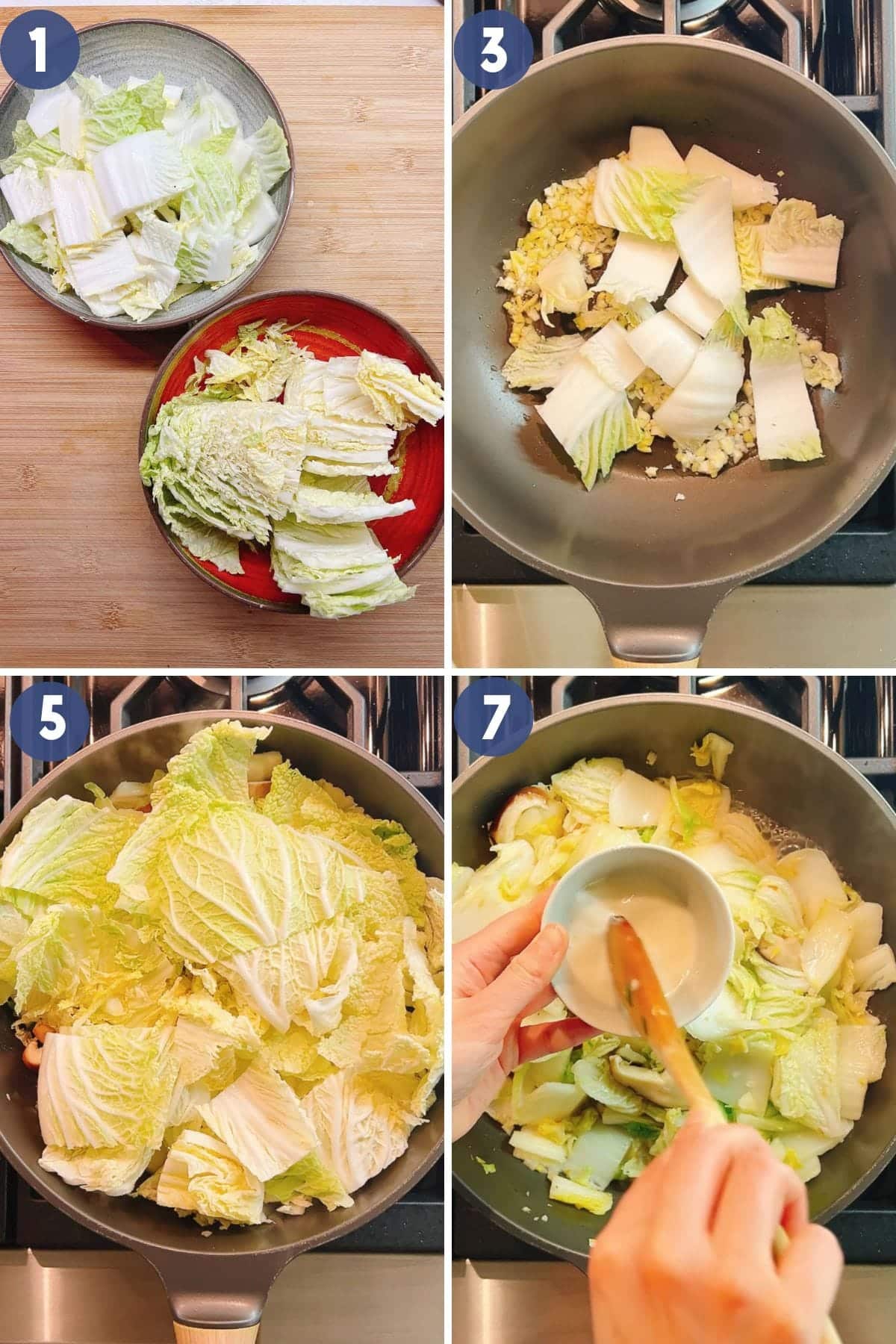
Step 1: Cut the cabbage properly to control the texture
This step is everything. Napa cabbage cooks fast—especially the leafy parts—so you want to cut the stems smaller than the leaves. This helps them cook at the same pace and keeps your stir-fry from turning mushy. Rinse them separately and let them drain well so you don’t add extra water to the pan.
Step 2: Have your aromatics and slurry ready before you start
Once you start cooking, things move fast. Get your garlic, ginger, and mushrooms sliced and ready to go. Stir together the tapioca starch and chicken stock ahead of time so the slurry’s smooth and ready when you need it. No clumps, no scrambling mid-cook.
Step 3: Start with aromatics and cabbage stems in a hot pan
A hot pan helps bloom the garlic and ginger quickly without burning. Add the cabbage stems first—they need a head start to soften up before the leaves go in. You should hear a nice sizzle here.
Step 4: Add the mushrooms and salt to build flavor early
Shiitake mushrooms add a rich, savory depth. Toss them in after the stems so they have a chance to soak up the aromatics and seasonings. A little salt at this stage starts layering the flavor.
Step 5: Toss in the leafy parts and stir just until wilted
Napa leaves cook in seconds. Add them after the mushrooms and sauté until they soften and start to wilt. You can add another splash of oil here if the pan feels dry. The stems should be slightly translucent and tender, while the leaves stay soft but not limp.
Step 6: Pour in the slurry to bring everything together
Give your slurry one more stir and add it to the pan. This quick step thickens the natural cabbage juices and creates a light, glossy coating. Toss for about a minute, just until the sauce clings nicely to the cabbage and mushrooms.
Step 7: Finish with sesame oil and adjust seasoning to taste
Turn off the heat and drizzle in toasted sesame oil for that nutty, fragrant finish. Taste and adjust with a pinch more salt if needed. Serve warm or at room temperature—it’s delicious either way.
What to serve it with
- This sautéed napa cabbage is light, savory, and goes with just about anything. For an easy dinner, pair it with protein-packed mains like my Chicken Cabbage Stir Fry, Ground Chicken Stir Fry with Green Beans, or some crispy Air Fryer Salt and Pepper Tofu.
- It’s also great with rice-based dishes. Try it with Golden Fried Rice, Chinese Sausage Fried Rice, or a cozy plate of Shanghai Rice Cake with Napa Cabbage and Bok Choy for a comforting combo.
FAQs
Nope! Just slice it properly and stir-fry it directly. Napa cabbage cooks quickly, so there’s no need to blanch—just make sure your pan is hot and the leaves are well drained.
Try these napa cabbage dishes next!
- Napa Cabbage Soup – One of the most popular soups on the blog, this comforting vegetarian recipe features soft napa cabbage and fluffy egg ribbons.
- Napa Cabbage Casserole – A cozy, Western-inspired twist with roasted napa cabbage and a bubbly, cheesy topping.
- Napa Cabbage Slaw – A fresh and crunchy slaw tossed in a miso ginger dressing and topped with crispy wonton chips.
- Braised napa cabbage – an easy one-pan side dish with garlic, ginger, and butter braising sauce.
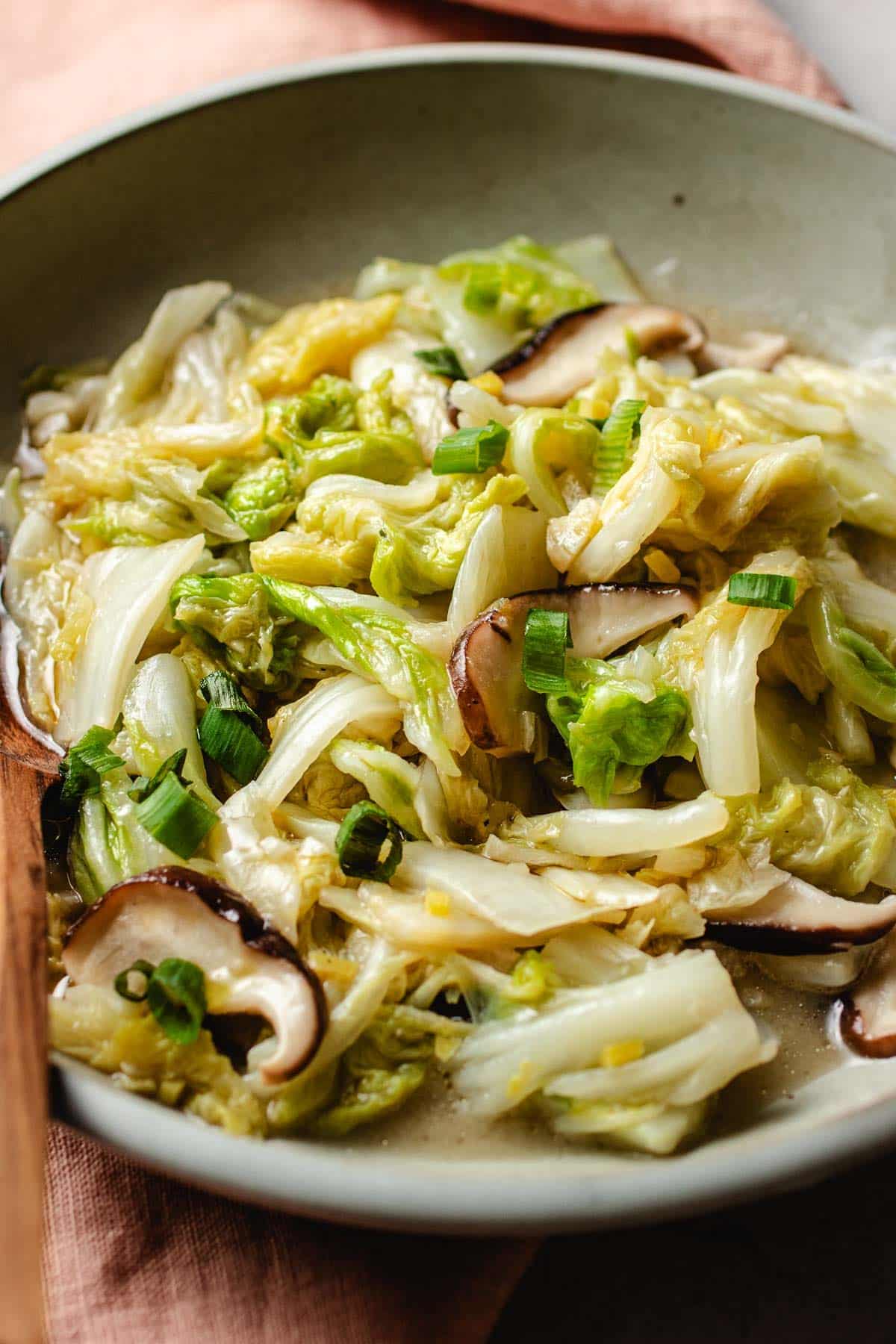
Sauteed Napa cabbage with shiitake recipe

Video
Ingredients
- 25 oz napa cabbage half of one medium
- 0.2 oz ginger finely minced, half of one thumb
- 0.8 oz garlic finely minced, 4 large
- 4 oz shiitake mushrooms sliced, 4 large caps fresh or rehydrated dried shiitake
- 2 tsp tapioca starch
- 2 tbsp chicken stock or water
- 1.5 -2.5 tbsp avocado oil or olive oil
- ½+1/4 tsp coarse sea salt or to taste
- 1 tsp Takii shiitake mushroom seasoning or chicken bouillon
- drizzle toasted sesame oil
Instructions
- Napa cabbage: Slice the napa cabbage lengthwise to halve it, then slice each half again to quarter it. Make a small angled cut to remove the core. Dice the cabbage stems into 1.5-inch (3.8 cm) sections and the leafy parts into 2.5-inch (6 cm) sections. Rinse the stems and leaves separately, then set aside to drain well.
- Aromatics + Slurry: Prepare the ginger, garlic, and shiitake. In a small bowl, mix the tapioca starch with the chicken stock to make a slurry.
- Saute cabbage stems: In a large sauté pan (12-inch / 30 cm wide), preheat over medium heat until it feels quite warm. Add 1.5 tbsp oil, swirl to coat, then add the ginger and garlic. Sauté for 5 seconds, then add the cabbage stems. Turn the heat up to medium-high and stir-fry for 1 minute.
- Season + Cabbage leaves: Add the shiitake and ½ tsp salt. Sauté for 1 minute, then add the leafy parts. Keep sautéing until the leaves turn slightly softer and wilted, about 1 to 1.5 minutes. Season with the remaining ¼ tsp salt and bouillon.
- If your pan feels dry, add 1 more tablespoon of oil to help with stir-frying. The cabbage stems should look slightly translucent—tender but not mushy—and the leafy parts should be just wilted.
- Add slurry: Stir the slurry again, then pour it into the pan. Scoop and toss continuously for 1 more minute until the liquid thickens, then turn off the heat.
- Garnish: Drizzle with toasted sesame oil. Taste and adjust with more salt, if needed. Serve warm or at room temperature.
Notes
- If you don’t have shiitake, you can skip it. It won’t affect the flavor of the dish.
- Prep and slice the cabbage right: Napa cabbage holds a lot of moisture, so rinse and drain it well before cooking. I always separate the stems and leaves, and slice the stems slightly smaller so they cook at the same pace. This keeps the texture tender—not mushy—and brings out that naturally sweet, umami-rich flavor.
- Keep the pan hot and don’t walk away: This dish cooks fast, so stay close. You want the stems tender but not soggy, and the leaves just wilted—not limp or watery. A large wok or sauté pan helps you toss everything quickly.
- Don’t skip the bouillon and sesame oil: These two ingredients bring the whole dish together. The bouillon adds depth and savory flavor, and the toasted sesame oil rounds everything out with a nutty finish. It’s a simple stir-fry, so you really need both.
- Make-ahead: You can slice the napa cabbage 1–2 days ahead, but wait to rinse until right before cooking so it stays fresh.
- Storage: Store leftovers in an airtight container in the fridge and enjoy within 3 days.
- Reheat: Microwave on medium and give it a quick stir halfway through to heat evenly.
Nutrition
Nutrition information is automatically calculated, so should only be used as an approximation.
Made a dish and loved it? Please rate the recipe and leave a comment in the section below! It helps my blog grow organically, allowing me to continue sharing free and awesome content with you. Thank you!

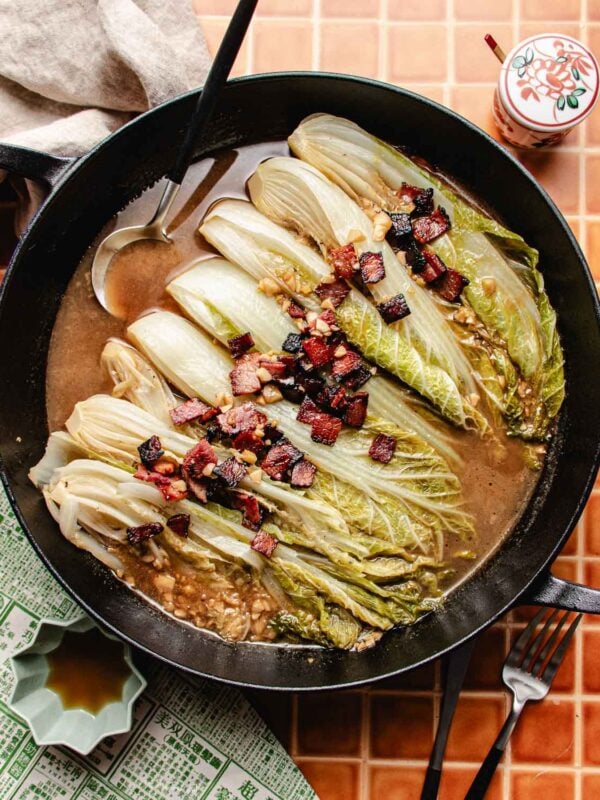











Another amazing recipe, Chihyu!! Super easy and fast yet tastes like it came from a restaurant! Will definitely make again and again! Love your recipes!!
Thank you so much! I appreciate it! 😀